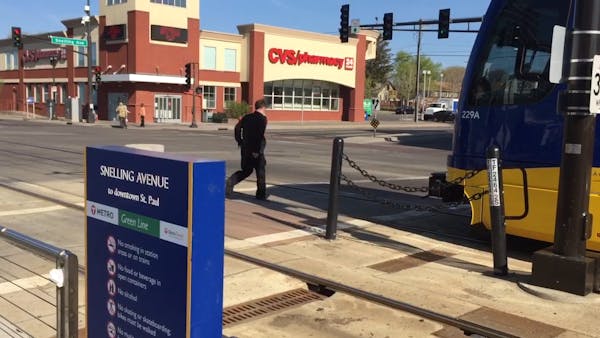David Levinson found himself stranded on a narrow slab of concrete on University Avenue recently, sandwiched between light-rail tracks as two Green Line trains approached, one from the east and one from the west, both blaring their horns.
Levinson, a professor of civil engineering at the University of Minnesota, crept forward as the first train passed. Then he took a step back, feeling the breeze as the second train rolled by. Luckily, the trains did not pass simultaneously, or he could have become the latest casualty on the Green Line.
Close calls like Levinson's are a daily occurrence along the 11-mile light-rail line that runs from downtown Minneapolis to downtown St. Paul, as pedestrians unable to get all the way across the bustling four-lane thoroughfare seek refuge in the narrow center median, where often there is barely enough clearance for two trains to pass.
To date, there have been seven collisions involving trains and pedestrians, including two fatalities. That's on top of many near-misses in which train operators have had to hit the emergency brakes to avoid hitting a pedestrian, said Mike Conlon, director of rail and bus safety for Metro Transit.
The Green Line in June recorded its first month without incident or accident since trains began running 15 months ago. In hopes of keeping that streak going, Metro Transit recently put down new pavement markings and signs in about 40 spots at and near Green Line platforms to discourage pedestrians from walking in areas that put them in harm's way.
The markings, in the form of bright yellow striping and stencils, show a pair of feet with a slash through them and the words "Do Not Wait Here."
Beware of medians
With the arrival of light rail on University Avenue, medians are no longer safe harbors. "When there was two-way rubber tire traffic, they'd wait in the median, and that seemed reasonable to do," Conlon said. "With the tracks, that is not reasonable at all. They use them [medians] as waiting areas. We don't want them doing that."
Yet many still do. Carol Swenson, executive director of the District Councils Collaborative of St. Paul and Minneapolis, which has worked to address safety and accessibility issues, said she cringes when she sees people start to cross University, then get caught in the middle of the street with nowhere to go because pedestrian signals don't stay on long enough.
"When I see people taking the greatest risk, myself included, is when the train I want to catch is coming and I'm standing at the corner waiting for the signal to change," Swenson said. "I've had to retrain myself to think it's only 10 minutes until the next train comes and that isn't such a long wait."
Swenson said she's glad to see Metro Transit doing something, but the bigger issue is that people need to be re-educated about crossing streets and walking around light rail.
Brian Fitch, a University of Minnesota graduate student who suggested several ways to improve pedestrian safety as part of a research project he and two others completed this spring, said the markings are a step in the right direction, but that more could be done.
"The paint is a good, low-cost way to improve awareness," he said. "The obvious limitation of paint is that it does not provide a physical barrier. You will only modify the behavior of those who were unaware of the danger associated with the area, and now know to stay out. Still, it's good to see. I hope they get the results they are looking for."
A driver's eye view
Even with the new markings, such as those at Dale Street and Snelling and Fairview avenues, light-rail operator and instructor Rolland Green said he still sees misbehavior. Last week he said he saw people standing on the "Do Not Wait Here" signs on the pavement. In another case, he pulled the emergency brake when he spotted a pedestrian illegally crossing the tracks at Snelling Avenue. The train screeched to rest in the intersection -- collision avoided.
"That makes your heart skip a beat," Green said. "We can't stop on a dime. We can do everything we can to have a safe railroad, but if the pedestrian is not going to pay attention, it is pointless. If people obey the safety procedures Metro Transit has in place, there would not be any accidents."
Conlon agrees that the markings are not a cure-all, but rather another educational tool to raise awareness. He pointed to the bright yellow chevrons painted on wide medians that could easily be mistaken for sidewalks, such as those paralleling University Avenue at Fairview.
"This is something a pedestrian would recognize," Conlon said. "It tells you, 'This is not for you. This is not a sidewalk.' It might get your attention. We are trying like heck to get their attention."
The recent incident-free run is encouraging, Conlon said, and he hopes the new markings will decrease the hazards and improve Metro Transit's safety record.
"Safety is a shared responsibility, and we are trying to make it better," he said. "If we don't do anything, they [close calls] become major injuries or fatalities."
Tim Harlow • 612-673-7768
State Sen. Nicole Mitchell off committee assignments while case under review

GOP endorses Tad Jude for congressional seat Dean Phillips is leaving
One day in the frantic life of a Children's Minnesota emergency room nurse

